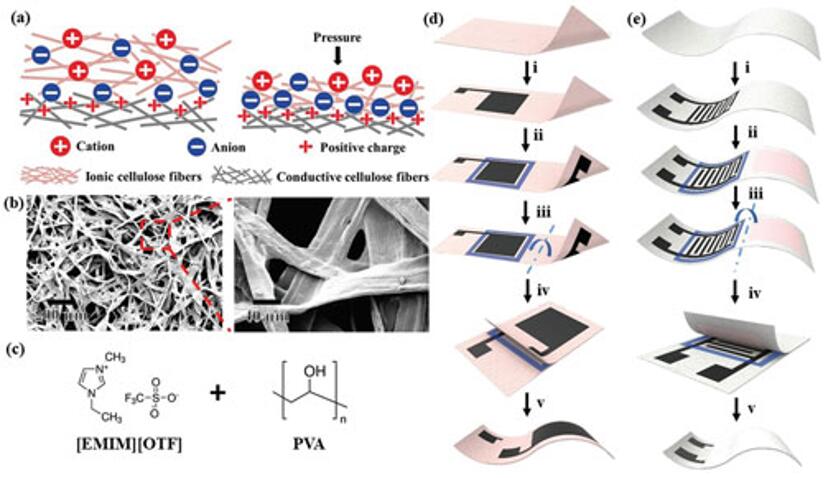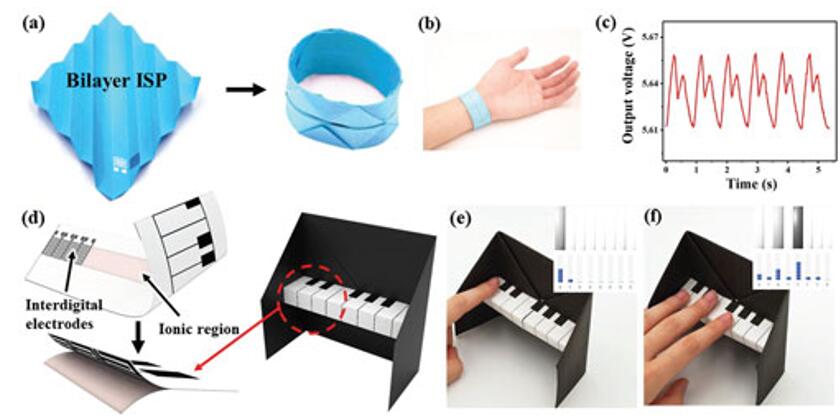According to MEMS Consulting, paper, as an easily accessible, low-cost, insulating, soft and portable material, has long been used as a flexible platform for chemical and biological sensing. For example, pH test strips, blood glucose test strips, and early pregnancy test strips are all widely used biochemical sensors .
As this field continues to develop, paper-based sensors based on nanotechnology are expected to become simple, portable, disposable, low-power and low-cost sensing devices that can be widely used in medicine, explosive and toxic substance detection and environmental research. Due to the fibrous structure of paper, they can be modified with functional additives, such as carbon-derived materials (such as carbon nanotubes and graphene), conductive polymers and metal nanocomposites, resulting in new functions and sensing modes.
Previously reported pressure-sensitive papers and pressure sensors made from them are mainly based on three existing sensing mechanisms, namely resistive, capacitive and triboelectric.
"Recently, we introduced a completely new pressure sensing mechanism, called flexible iontronic sensing (FITS), which senses capacitance changes by exploiting the pressure between an electrode and an ionic surface," said Tingrui Pan, a professor at the University of California, Davis. "It is noteworthy that, unlike traditional resistive and capacitive sensing methods, the iontronic pressure sensor based on the unique FITS mechanism has extremely high sensitivity and resolution, while parasitic noise can be largely ignored due to its extremely high signal-to-noise ratio."

a) Pressure response mechanism of ionic pressure sensing paper (ISP) device, in which fibrous ions serve as ionic regions and conductive fibers serve as conductive regions; b) Scanning electron microscope (SEM) image of ISP ion region; c) Molecular structure description of ionic liquid and polymer matrix; d) Preparation of ISP device with "sandwich" structure: i) Printing top electrode on ionic paper; ii) Printing bottom electrode on the back of ionic paper; iii) Printing bonding pattern for integration; iv) Folding to form a "sandwich" structure; v) Finally, packaging and integration; e) Preparation of ISP device with double-layer structure: i) Printing interdigitated electrodes on ordinary paper; ii) Printing ionic ink on the designed area; iii) Printing bonding pattern for integration; iv) Folding to form a double-layer structure; v) Finally, packaging and integration.
In their latest paper, "All-in-one ionic electronic sensing paper," published in the journal Advanced Functional Materials, Professor Pan and his collaborators introduced a monolithic ionic electronic paper substrate that contains both ionic and electrode regions, which can serve as an integrated flexible sensing platform.
Professor Pan pointed out: "Our new sensing paper extends the principle of ion-sensing to a more adaptable material system that is directly printable, custom cuttable, and 3D foldable at low cost, just like regular paper."
Now we can build a pressure sensing platform through simple paper-specific operations such as printing, cutting, gluing and folding. Since pressure sensing devices are no longer limited to being constructed in a flat form, 3D pressure sensing origami can now also be used to detect spatial pressure.
Basically, everything and every surface around us can be used as a sensing structure, such as in smart toys, smart packaging, health wearable devices, disposable electronics, wallpapers, furniture, etc., and even as a flexible human-machine interface.
Professor Pan said: "This technology ushers in a new era where everything we touch has tactile capabilities, and people can communicate with any object by touching, pressing and tapping, providing a comprehensive human-computer interface through visual, auditory and tactile input."

a) The ISP origami bracelet is prepared by printing and folding; b) The ISP origami bracelet can be used for pulse monitoring; c) The pulse wave signal collected by the ISP origami bracelet; d) The ISP origami piano is prepared with a pressure-sensitive keyboard; e, f) The ISP origami piano with force sensing function can detect pressure and control the volume.
However, there are still some problems to be solved. For example, the interconnection problem: the current signal interconnection between paper electronic devices and signal processing systems through conductive glue is still unstable. However, Professor Pan's team believes that this problem can be solved through low-temperature welding and special paper FPC (flexible printed circuit) interconnection grooves.
"Research on sensor devices is no longer just about the sensing element. Power supply, signal processing and electronic circuits should all be taken into account. Such integrated devices should also be compatible with skin, fabric, etc., both in shape, modulus and function." Professor Pan concluded
Previous article:Advantages of Micro Fiber Optic Pressure Sensors in the Medical Field
Next article:Analysis of wireless transmission technology based on wearable medical system chips
- Popular Resources
- Popular amplifiers
- High-speed 3D bioprinter is available, using sound waves to accurately build cell structures in seconds
- [“Source” Observation Series] Application of Keithley in Particle Beam Detection Based on Perovskite System
- STMicroelectronics’ Biosensing Innovation Enables Next-Generation Wearable Personal Healthcare and Fitness Devices
- China's first national standard for organ chips is officially released, led by the Medical Devices Institute of Southeast University
- The world's first non-electric touchpad is launched: it can sense contact force, area and position even without electricity
- Artificial intelligence designs thousands of new DNA switches to precisely control gene expression
- Mouser Electronics provides electronic design engineers with advanced medical technology resources and products
- Qualcomm Wireless Care provides mobile terminal devices to empower grassroots medical workers with technology
- Magnetoelectric nanodiscs stimulate deep brain noninvasively
- Innolux's intelligent steer-by-wire solution makes cars smarter and safer
- 8051 MCU - Parity Check
- How to efficiently balance the sensitivity of tactile sensing interfaces
- What should I do if the servo motor shakes? What causes the servo motor to shake quickly?
- 【Brushless Motor】Analysis of three-phase BLDC motor and sharing of two popular development boards
- Midea Industrial Technology's subsidiaries Clou Electronics and Hekang New Energy jointly appeared at the Munich Battery Energy Storage Exhibition and Solar Energy Exhibition
- Guoxin Sichen | Application of ferroelectric memory PB85RS2MC in power battery management, with a capacity of 2M
- Analysis of common faults of frequency converter
- In a head-on competition with Qualcomm, what kind of cockpit products has Intel come up with?
- Dalian Rongke's all-vanadium liquid flow battery energy storage equipment industrialization project has entered the sprint stage before production
- Allegro MicroSystems Introduces Advanced Magnetic and Inductive Position Sensing Solutions at Electronica 2024
- Car key in the left hand, liveness detection radar in the right hand, UWB is imperative for cars!
- After a decade of rapid development, domestic CIS has entered the market
- Aegis Dagger Battery + Thor EM-i Super Hybrid, Geely New Energy has thrown out two "king bombs"
- A brief discussion on functional safety - fault, error, and failure
- In the smart car 2.0 cycle, these core industry chains are facing major opportunities!
- The United States and Japan are developing new batteries. CATL faces challenges? How should China's new energy battery industry respond?
- Murata launches high-precision 6-axis inertial sensor for automobiles
- Ford patents pre-charge alarm to help save costs and respond to emergencies
- New real-time microcontroller system from Texas Instruments enables smarter processing in automotive and industrial applications
- When multiple slaves successfully connect to the host, how can the host know which slave is sending data?
- Questions about the display screen supported by GUI
- Teach you how to apply for a free trial of the new generation of oscilloscope 40 functional software
- Evaluation Weekly Report 20211108: Playing with domestic FPGA is full of pitfalls, but you can also have fun + Topmicro smart display module, etc.
- The msp430 microcontroller sends floating point numbers to the host computer through the serial port
- Talking about software architecture from a historical perspective - DOS era (Part 2)
- Bicycle modification series: Hot Wheels
- Participate in TE's prize-giving event and solve the problems of smart meters!
- WiFi remote control coffee shop equipment
- Tencent employees were fired for working less than 8 hours a day. What kind of work system is reasonable?

 Adaptive blind source separation algorithm based on high-order statistics
Adaptive blind source separation algorithm based on high-order statistics How to Select a Compensated Silicon Pressure Sensor
How to Select a Compensated Silicon Pressure Sensor Turck pressure sensor [Turck_Pressure_sensor] user manual [official information]
Turck pressure sensor [Turck_Pressure_sensor] user manual [official information]
















 京公网安备 11010802033920号
京公网安备 11010802033920号